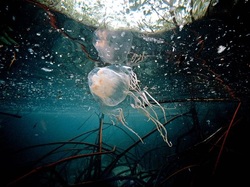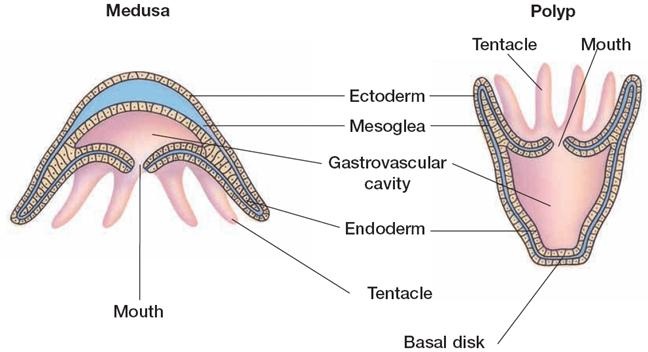Body Forms
Cnidarians can either have two different body forms...
Medusa: the mobile body form, shaped like an umbrella. The mouth and anus of a medusa points downward and is on the bottom of its body. Cnidarians of the medusa body form reproduce sexually. This body form is associated with the jellyfish.
Polyp: the sessile body form. The mouth and anus of a polyp points upward. Most polyps reproduce asexually through budding. This body form is associated with coral, sea anenomes, etc.
Medusa: the mobile body form, shaped like an umbrella. The mouth and anus of a medusa points downward and is on the bottom of its body. Cnidarians of the medusa body form reproduce sexually. This body form is associated with the jellyfish.
Polyp: the sessile body form. The mouth and anus of a polyp points upward. Most polyps reproduce asexually through budding. This body form is associated with coral, sea anenomes, etc.
Anatomy & Classes
The phylum Cnidaria contains four major classes:
Anthozoa... sea aenenomes, coral: the Anthozoa group contains the corals that build massive reefs in tropical waters. This group also contains sea anemones. These cnidarians also have a long fossil record that dates back to 550 million years.
Cubozoa... box jellyfish: Cubozoan jellyfish are very similar to Schypozoa jellyfish, except Cubozoan jellyfish have box-shaped heads, as well as four evenly spaced tentacles. But both jellyfish are functionally identical. Chironex flickeri aka the "sea wasp" or "box jellyfish" is known as the deadliest box jellyfish on earth. Their stings are capable of killing people.
Hydrozoa... hydras, Portugese Man-o' War: some hydrozoans switch between a polyp and medusa. A Hydra, however, spends its entire life as a polyp. A good chunk of hydrozoans are colonial polyps that can form branched networks with other polyps, as well as fire coral which resembles true coral. There is also an unusual colonial organism called the "Portugese Man-o' War" which looks like a jellyfish but is actually many polyps with different functions.
Schyphozoa... jellyfish: contains the "true" jellyfish. The size of the jellyfish in this group and the length of their tentacles can vary. Some can either be very small and have shorter tentacles, or they can be very large and have unusually long tentacles.
Anthozoa... sea aenenomes, coral: the Anthozoa group contains the corals that build massive reefs in tropical waters. This group also contains sea anemones. These cnidarians also have a long fossil record that dates back to 550 million years.
Cubozoa... box jellyfish: Cubozoan jellyfish are very similar to Schypozoa jellyfish, except Cubozoan jellyfish have box-shaped heads, as well as four evenly spaced tentacles. But both jellyfish are functionally identical. Chironex flickeri aka the "sea wasp" or "box jellyfish" is known as the deadliest box jellyfish on earth. Their stings are capable of killing people.
Hydrozoa... hydras, Portugese Man-o' War: some hydrozoans switch between a polyp and medusa. A Hydra, however, spends its entire life as a polyp. A good chunk of hydrozoans are colonial polyps that can form branched networks with other polyps, as well as fire coral which resembles true coral. There is also an unusual colonial organism called the "Portugese Man-o' War" which looks like a jellyfish but is actually many polyps with different functions.
Schyphozoa... jellyfish: contains the "true" jellyfish. The size of the jellyfish in this group and the length of their tentacles can vary. Some can either be very small and have shorter tentacles, or they can be very large and have unusually long tentacles.
Digestion
Both polyps and even jellyfish don't seek out food. Instead they wait for prey to get caught in their stinging tentacles. Once a fish is caught and paralyzed by the toxin from the cnidocytes, the cnidarian reels in the fish toward its mouth. The fish is then digested by the gastrovascular cavity. Nutrients are then distributed throughout the cnidarian's body and any waste is expelled through the mouth or anus.
Representative Organism: Chironex fleckeri

- Part of the class cubozoa
- Scientific name: Chironex fleckeri
- Common name: Box jellyfish
- About 10 feet long, 10 inches wide
- Can weigh up to 4.4 pounds

- Live in coastal waters off Northern Australia and near the Indo-Pacific
- Box jellyfish eat mostly small fish
- Unlike other jellyfish, box jellyfish are capable of moving rather than just drifting
- All four sides of their bell contain a cluster of six eyes, each with their own lens, iris, retina, and cornea
- Scientists aren't completely sure how they can see without a brain
Source for cnidarian info:
http://animals.about.com/od/cnidarians/Cnidarians_Phylum_Cnidaria.htm
Source for box jellyfish:
http://animals.nationalgeographic.com/animals/invertebrates/box-jellyfish/
Similarities with poriferans
- The polyp form of cnidarians, like sponges, are sessile
- Cnidarians and poriferans are diploblastic
- Sponges and polyps are capable of sexual or asexual reproduction
- Sponges and polyps float around at a very young age before they attach themselves to an object
- Cnidarians and poriferans are carnivorous
- Cnidarians and poriferans lack true tissue or organs
- Cnidarians and poriferans are invertebrates

